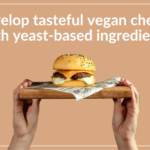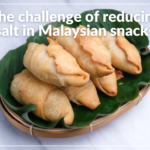Two of our Biospringer experts held a webinar entitled “Unlocking yeast extract solutions for tastier and nutritious 2.0 plant-based meat, seafood & dairy”. They introduced concrete solutions to tackle three challenges faced by food manufacturers when formulating their plant-based foods, using clean label yeast extracts. Indeed, this natural origin and clean label ingredient achieves flavorful and nutritious plant-based alternatives.
The plant-based market trend in Asia Pacific
According to Food Navigator Asia, the plant-based market in Asia Pacific is expected to witness a growth by four between 2020 and 2030, from US$13.5bn to US$64.8bn.1 “This means that a growing part of the population supports the plant-based segment. In fact, consumers are more and more conscious of what they consume because of several concerns about health, ethical, environment, etc.” explains our expert. Actually, 21% of Asia Pacific consumers prefer plant-based to animal-based protein.²
From 1.0 mock meat to 2.0 plant-based alternatives
Even in the COVID19 context, the plant-based segment is still going strongly. Originally, mock meat was fundamentally produced to correspond to the dietary requirements of vegetarians. But today, the 2.0 plant-based foods involve better taste, texture and nutritious profile, as close as possible to the original foods, to attract flexitarians.
WATCH OUR
WEBINAR!
Three steps to create 2.0 plant-based foods
More than a trend, this phenomenon is also starting to tap into the quick service restaurants. This market opportunity is huge for food manufacturers. However, they are facing three main challenges to realize the perfect plant-based alternative.
1. Masking undesirable off-notes
Soy, beany, green, and other off-notes are naturally present in plant-based proteins. These are common technical challenges faced during the development of plant-based foods. As such, it is important to mask the off-notes from the protein base. However, we don’t want to affect the original flavor profile. Considering this challenge, we have developed a new solution with Springer® Mask range of yeast extracts. The aim is to help manufacturers conceal off-notes from the plant-protein matrix before adding seasonings. If you want to know more about our off-notes masking solution, download our leaflet here.
2. Enriching the nutritional profile
The protein off-notes are now masked. However, there is a second challenge. It is to enrich the nutritional profile of your plant-based foods, as very little plant proteins are actually a great nutritional alternative to real meat, fish or dairy. Our Springer® Proteissimo 101 yeast protein is the solution you may be looking for.* With a PDCAAS3 score equal to 1 (higher than the FAO4 recommendations) and a DIAAS5 equal to 1.02, our yeast protein is more nutritious than most of the proteins now available on the market.
3. Creating or enriching characteristic taste
As our experts explain in this webinar with many food applications examples, our Springer® Reveal range of yeast extracts synergizes with different seafood flavor ingredients as well as sea-based ingredients such as algal oil and seaweed, creating appealing and tasty plant-based fish alternatives. They also developed other innovative solutions to mimic the sensory attributes of real meat and dairy for example, our Springer® Signature range helps to bring authentic meat taste profiles such as beef, chicken or dairy taste profiles like cheese to the matrix.
Our solutions in plant-based development
At Biospringer, we have strong ingredient capabilities. We help overcome challenges with four dedicated solutions, thanks to a dedicated portfolio of clean label yeast extracts. We mask off-notes, enrich the nutritional profile, intensify the flavors and provide signature taste with our yeast extracts. With a regional team of experts based in their own countries, and a technical team based in Singapore, we have a localized expertise of taste that corresponds to Asia Pacific consumers expectations. Our Culinary Centre team, dedicated to support our customers in their formulations challenges, is available to explain the potential of yeast extract. According to Innova Database, from 2018 to 2023 in Asia Pacific, 415 of the meat analogues new products launched, 57 of the dairy analogues ones, and 24 of the seafood analogues NPL are using yeast extract. Watch our webinar replay to learn more!
1 Food Navigator Asia, Double opportunity: Why both affordability and premiumisation are providing plant-based promise in APAC, 2022
2 Good Food Institute, 2021
3 Protein Digestibility Corrected Amino Acid Score
4 The Food and Agriculture Organization
5 Digestible Indispensable Amino Acid Score
*This product is only available in specific countries of Asia Pacific. Please contact us to know more.









